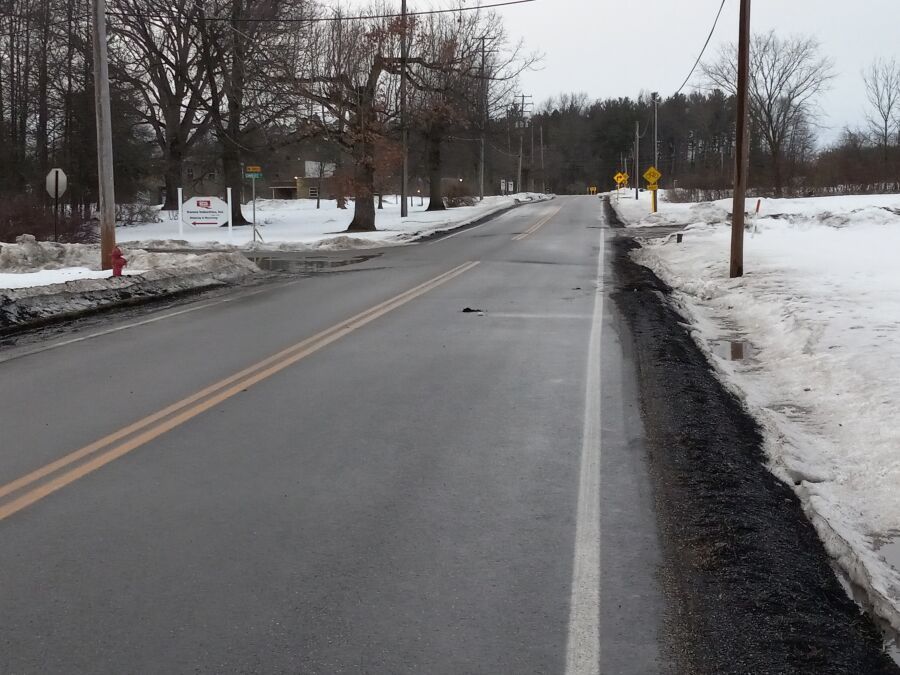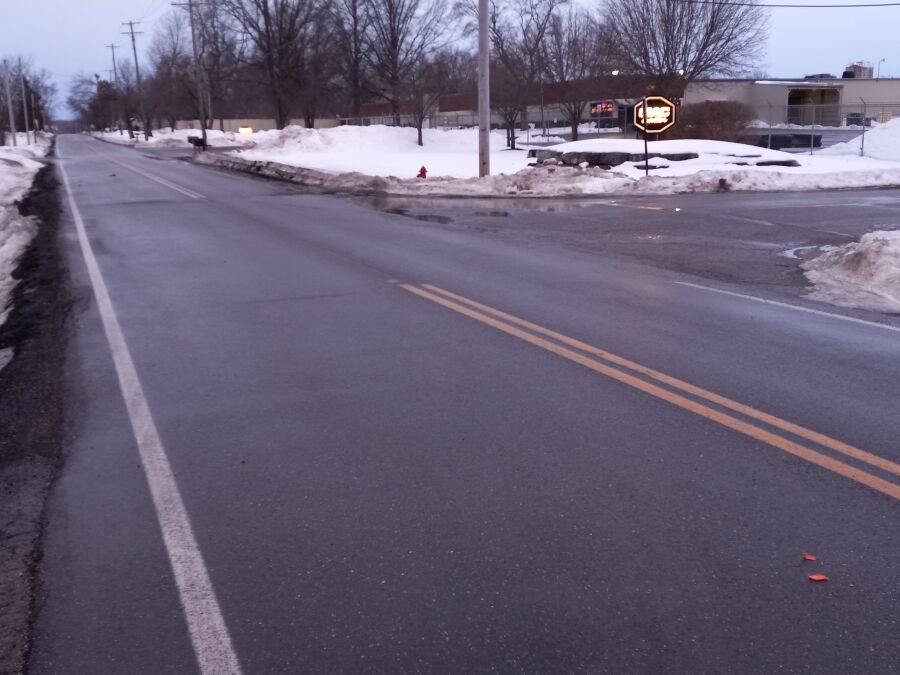Are You In The Ditch?
Topic 31464 | Page 2
+1 on turning too wide. When the turn is tight (which is not the case here), and some wheels must go off the pavement, I always try to make it my tandems , not the tractor wheels - if your drives have a good traction, your chances of getting out are much higher.
Tandems:
Tandem Axles
A set of axles spaced close together, legally defined as more than 40 and less than 96 inches apart by the USDOT. Drivers tend to refer to the tandem axles on their trailer as just "tandems". You might hear a driver say, "I'm 400 pounds overweight on my tandems", referring to his trailer tandems, not his tractor tandems. Tractor tandems are generally just referred to as "drives" which is short for "drive axles".
Tandem:
Tandem Axles
A set of axles spaced close together, legally defined as more than 40 and less than 96 inches apart by the USDOT. Drivers tend to refer to the tandem axles on their trailer as just "tandems". You might hear a driver say, "I'm 400 pounds overweight on my tandems", referring to his trailer tandems, not his tractor tandems. Tractor tandems are generally just referred to as "drives" which is short for "drive axles".
I’m thinking a button hook turn would have been very advantageous in this situation. Traffic doesn’t seem to be any hindrance.
I’m thinking a button hook turn would have been very advantageous in this situation. Traffic doesn’t seem to be any hindrance.
Hay, Bruce . . .
He WAS trying a button hook. Pretty sure you meant jug handle. :)
TwoSides, I as well, am sorry this happened to you.
I wish I came across this thread before the 3rd of this month. Rookie driver here had to learn the hard way to slow down when conditions are not ideal. I though my truck being as heavy as it was that I was at a lot lesser of a risk of losing control in bad weather. BOY was I wrong! Lesson learned, it’s much better to slow down traffic than to not be moving at all in a ditch!!
What happened on the 3rd, Tay?
Man, I wish I could find it. Pretty sure it was Old School's thread, about the stopping on compromised pavement, being heavy or light .. being more optimal. Brett, G, Errol ... all contributed.
Great thread. If I find it (or y'all do?) let's bump it.
I'm sorry to BOTH of you, guys. Like the others said, it happens.
Just DANG.
~ Anne ~
What would I have done differently? I honestly don't know. I thought I had the turn completed until the driver steer slide into the ditch.
I stopped about 3ft before the stop sign to let a car make a left turn in front of me and go down the street I was coming up. If there was a yellow line in the road I would have been directly on it. Anymore to the left and I would have been in the opposite lane. I thought my set up was good then proceeded with a button hook turn. Didn't see the ditch until I was riding along side it and before I could do anything about it the truck slide in. That was a "OH NO!" moment, but not exactly those words lol.
If I saw the ditch before the turn I would have done a jug handle turn maybe? That way I wouldn't have went that far out into the other lane.
I know to never let the steers go off the pavement. I definitely wasn't aiming for that lol. If the ditch wasn't there I wouldn't have even touched the grass. The steers were riding along side it and slide over, maybe the weight of the truck and the way of the pavement made the truck slide.
The turn was a little tight in my opinion, maybe the picture doesn't show it or maybe my rookie eyes or maybe I was having a rough week and wasn't thinking clear.


HOS:
Hours Of Service
HOS refers to the logbook hours of service regulations.Looks like a slow street with not much traffic? If so, I would have signaled a right turn. Once definitely clear, swing some to the left at the intersection, then completely stop as you did. Let any traffic clear so you can make the turn, constantly watching the mirrors for obstructions (signs) and for impatient cars that may try to cut in from your right side. You must also maintain situational awareness. For right turns, "Go Straight, Then Turn Late."
The “Go straight, turn late” rule is a good one to remember. When I recently had my 120 day evaluation, that was my only negative mark because I didn’t execute two right hand turns exactly right.
It also goes hand in hand with what Old School says: Can’t drive a truck like a car. Turns are much more critical.
For right turns, "Go Straight, Then Turn Late."
Is it possible that you can turn too late? I'm still getting a feel for the judgment on when to turn late on button hook turns. I mainly do jug handle because I feel more comfortable doing that with split axles
I tried a button hook here when I should have done a jug handle. I was concerned that I wouldn't clear the stop sign with a jug handle because the road wasn't that wide. With the button hook I was going to keep coming in towards the right then back to the left so the rear of the trailer would clear the sign.
Yes it is possible to turn too late, as you painfully discovered. You are on the right path as revealed by your use of the term judgement. Takes time to develop good judgement. Good judgement springs from bad judgement. The saying I like is: “Experience is a hard teacher because it gives the test first and the lesson afterward.
And GOAL is not just for backing. In going forward and you are in doubt, GOAL if it is safe to do so. Might keep that left steer wheel out of the mud.
For right turns, "Go Straight, Then Turn Late."
Is it possible that you can turn too late? I'm still getting a feel for the judgment on when to turn late on button hook turns. I mainly do jug handle because I feel more comfortable doing that with split axles
I tried a button hook here when I should have done a jug handle. I was concerned that I wouldn't clear the stop sign with a jug handle because the road wasn't that wide. With the button hook I was going to keep coming in towards the right then back to the left so the rear of the trailer would clear the sign.
Yes it is possible to turn too late, as you painfully discovered. You are on the right path as revealed by your use of the term judgement. Takes time to develop good judgement. Good judgement springs from bad judgement. The saying I like is: “Experience is a hard teacher because it gives the test first and the lesson afterward.
And GOAL is not just for backing. In going forward and you are in doubt, GOAL if it is safe to do so. Might keep that left steer wheel out of the mud.
TwoSides, I've got Tom dictating to me here, after seeing this. FWIW. He pulled flats when asphalt was cold. The trailers DO NOT move like anything else. Going from TANKS to FLATS was a heck of a learning curve. He wasn't properly trained in either, but .. OTR with Transport America, USX, FX/LH (doubles...) and then, got the tank job. Pretty much self taught, but for the doubles & reefers.
He'd been driving for numerous years, so he just 'got the feel' for it. In 'his' words' (yeah, Bruce!) ... he would've done a combination jug & button. Swing left (a bit, so idiots coming down the road towarding that 'would be/could be' pot hole .. .so maybe THAT was a fear?
PackRat's advice is the SPOT ON.... as the 'fat boi' in my avatar says, too. Problem is; seemed like you turned TOO late. (YET, you can still carry on) and swipe tight (ergo the button hook.) He thinks you were shy about your fixed tandems and that wet spot being a pot hole... perhaps?
I'm no driver, but I've been with a driver for many years. As Tom advises... "Stay tight UNTIL you turn right. .. " Man of few words. Tom says "I bet he was afraid of having his tandems (and the belly bag) in a pothole." The one before the turn.
Bruce K. .. a 'baby jug' would've probably helped. Immensely.
TwoSides; keep your head up! It's over, it's emblazoned. You can hit up the 'ole guy' here, anytime. It's a learning experience... his words. Carry on, move forward, be safe!
~ Anne & Tom ~
OTR:
Over The Road
OTR driving normally means you'll be hauling freight to various customers throughout your company's hauling region. It often entails being gone from home for two to three weeks at a time.
Tandems:
Tandem Axles
A set of axles spaced close together, legally defined as more than 40 and less than 96 inches apart by the USDOT. Drivers tend to refer to the tandem axles on their trailer as just "tandems". You might hear a driver say, "I'm 400 pounds overweight on my tandems", referring to his trailer tandems, not his tractor tandems. Tractor tandems are generally just referred to as "drives" which is short for "drive axles".
Tandem:
Tandem Axles
A set of axles spaced close together, legally defined as more than 40 and less than 96 inches apart by the USDOT. Drivers tend to refer to the tandem axles on their trailer as just "tandems". You might hear a driver say, "I'm 400 pounds overweight on my tandems", referring to his trailer tandems, not his tractor tandems. Tractor tandems are generally just referred to as "drives" which is short for "drive axles".
Doubles:
Refers to pulling two trailers at the same time, otherwise known as "pups" or "pup trailers" because they're only about 28 feet long. However there are some states that allow doubles that are each 48 feet in length.
Reefer:
A refrigerated trailer.
New Reply:
New! Check out our help videos for a better understanding of our forum features

















Preview:
This topic has the following tags:
Adverse Conditions Advice For New Truck Drivers Dealing With The Weather Photos Safe Driving Tips Truck Driving Stories







 TT On Facebook
TT On Facebook
I wish I came across this thread before the 3rd of this month. Rookie driver here had to learn the hard way to slow down when conditions are not ideal. I though my truck being as heavy as it was that I was at a lot lesser of a risk of losing control in bad weather. BOY was I wrong! Lesson learned, it’s much better to slow down traffic than to not be moving at all in a ditch!!